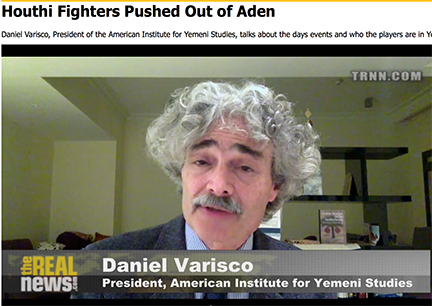
The first part of my interview about the current situation in Yemen on The Real News…
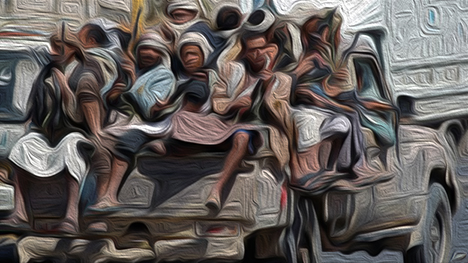
All eyes at the moment are glued to the news about the aerial attacks by a coalition of Saudi, GCC and Jordanian planes (with more to come it seems) on Huthi and military targets in Yemen. This is not a scenario I want to see; this is not a commentary I want to write. Yemen is imploding, the victim of long standing foreign involvement, local rivalries fueled by the insecurity with the removal of Ali Abdullah Salih and, in large part, the insatiable drive of Salih and his supporters to regain power. The Arab Spring removal of Salih was relatively peaceful, at least in terms of a military standoff and an explosion that could easily have ended Salih’s life but for the grace of the Saudis to put him back together. Guns abound in Yemen, as everyone knows, but the kind of hate-fueled warfare that has engulfed Iraq and Syria had not erupted. There was a national dialogue that most, but not all, groups participated in. There was a glimmer of hope.
This morning that glimmer seemed much dimmer, following on the rapid turn of events since the Huthi takeover of Sanaa and the recent escape of President Hadi to Aden. Yemen’s fragmented military is no match for the Saudi coalition arsenal directed by American intelligence. A bunch of gabilis in pick-up trucks may look tough on first glance, but they might as well be riding chariots. Reports suggest Saudi Arabia has assembled a force of some 150,000 at their border, with fears that a local RISK game will break out after the bombing has nullified the capacity of the Huthis to resist any advance. Continue reading As Yemen implodes
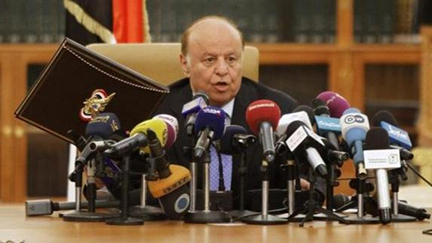
President Hadi, who is currently governing from Aden
Yemen’s legitimacy crisis is not new but is critical
By: Sama’a al-Hamdani, al-Araby al-Jadid, 3 March, 2015
On February 21, Yemen’s President Abd-Rabbo Mansour Hadi, escaped the Houthi-mandated house arrest and successfully fled to the southern city of Aden. A few hours later, al-Jazeera television broadcast a statement by the then resigned president. At the end of the statement, Hadi signed his name, “Abd-Rabbo Mansour Hadi, President of the Republic of Yemenâ€. It strongly suggested he had withdrawn his resignation.
So Yemen is now left arguably with two former presidents (Hadi and Ali Abdullah Saleh), a hugely powerful rebel militia leader (Abdulmalik al-Houthi), several secessionist movements (a couple of Southern Hiraks, a Marib Hirak and a Tihaman Hirak), UN-backed transitional committees, and two transitional agreements (The Gulf-Cooperation Council (GCC) transitional deal of 2011 and The Peace and Partnership Agreement of 2014).
In this confusion what, or rather, who, has legitimacy? Continue reading Yemen’s legitimacy crisis

by Samaa Al Hamdani, Fikra Forum, February 20
[For this article in Arabic, click here.)
Last September, a rebel militia known as the Houthis successfully captured large portions of Yemen’s north and its capital, Sana. A few months later, in January 2015, President Abdu Rabu Mansour Hadi and his government resigned following clashes with the Houthis. By February 10, diplomatic missions in Sana’a had evacuated the country to protest the “illegitimate Houthi takeover.†Overnight, the Houthis became Yemen’s new rulers, but very little was known about them.
The enigmatic Houthi movement transformed from a Zaydi revivalist group in the early 1990s, to a rebel movement in the mid-1990s, to an enemy warring against the Yemeni state in the early 2000s. Following the revolution in 2011, the Houthis secured 33 seats in the National Dialogue Conference (NDC), because they had significant local influence and were considered victims of the former regime. The Houthis were granted a specialized committee in the NDC solidifying them as an influential political player. However, as soon as the dialogue concluded, the Houthis lost faith in the internationally backed political transition. Since then, the Houthis – led by Abdul-Malik al-Houthi – have employed Machiavellian tactics to gain influence in Yemen, taking advantage of the dismal performance of Hadi’s National Unity Government to seize territory and power.
In September 2014 Hadi lifted fuel subsidies, which angered much of the Yemeni population and provided an opening for the Houthis. Cleverly, the Houthis sided with the people against the government; thereafter, within six days, they seized the capital. Months later, on February 11, they mobilized mass protests to overshadow any activities by the opposition. It is likely that a Houthi-led protest will take place on March 18, the anniversary of the “Friday of Dignity,†during which 56 protestors were killed in 2011. By hijacking public rallies, the Houthis aim to silence the opposition and, in this specific case, avoid criticism by the Gulf Cooperation Council and the United Nations Security Council.
Continue reading Lessons in Yemeni Machiavellianism

By Stacey Philbrick Yadav, The Monkey Cage, Washington Post, February 2
This post is part of the “Islamist Politics in the Shadow of the Islamic State†symposium.
A Houthi, an Islahi and an independent Islamist walked into a bar. Okay, actually, it was a conference room. It was 2012, and these three youth leaders from rival movements stood together across from a group of similarly diverse secular youth, debating the possibility of a madani (civil) state in Yemen built on an Islamic foundation. In that moment, they were what I call Islamist republicans, more than they were Shafai or Zaydi Muslims (let alone Sunni or Shiite), or members of any particular political organization. By this I mean that they shared an ideological convergence made possible by the upheavals of 2011. That solidarity has been largely (but not entirely) eroded by events over the past two years. But in that moment, those commitments were real and sensible in the context of Yemeni politics. The erosion of the concept of Islamist republicanism in Yemen over the past two years of “transition†has troubling implications for the ability to sustain many Yemenis’ dream of a civil state.
Yemen’s current spiraling crises can be read in light of the proxies and flows of interests outside of Yemen as much as within it. This is not to say that domestic politics aren’t primary – they establish the basic terrain of conflict, without a doubt. But since 2011, Yemen’s politics have been continually negotiated by a complex (often opaque) web of actors stretching from Riyadh in Saudi Arabia and Tehran to Washington and London. This has entailed both qualitative and quantitative shifts in the nature of foreign interest and action in Yemen, much of it driven by anxieties over or misunderstandings of Islamic republicanism. In the face of the transitional government’s resignation on Jan. 22, it became less clear than ever who is actually in charge of what in Yemen. Continue reading Yemen’s Houthis and Islamist republicanism under strain
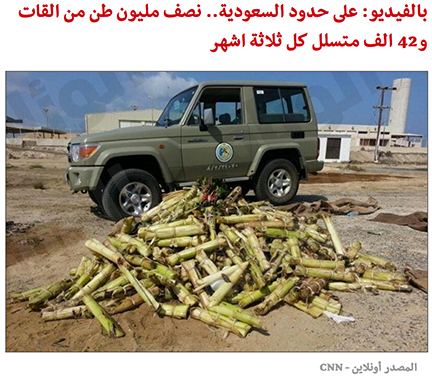
The media news network CNN sent reporter Nic Robertson to the border of Saudi Arabia and Yemen, where he was given a tour and saw several of the Yemenis caught smuggling over the border. One of the items being smuggled was qat. A young boy was given $50 to smuggle it into Saudi territory. The authorities tell him that in the past three months they captured close to half a million tons of qat worth 100 million dollars on the street. Here is one way the Huthis are getting cash. The report indicates that the Saudis are spending a lot of money to build fences and guard towers, although much of the border is so rugged it is impossible to stop everyone. Robertson is a bit overactive in his role at one point telling the Saudi interior spokesman with him that the Iranians are behind the Huthis and then saying this is what the Saudis say. I suspect it is what the Saudis say, but it was presented as a statement in the excerpt provided.
You can watch the video here in English, here in Arabic and read about it in Arabic here.

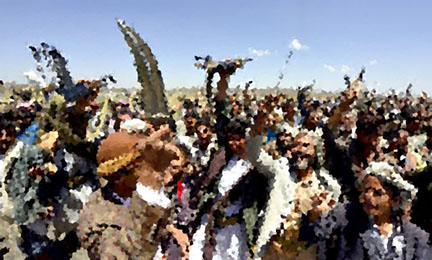
Are the Houthis a symptom of regional mistrust?
by Abdullah Hammidaddin, alarabiya.net, Saturday, 20 September 2014
Ten years ago this month Ali Saleh had ordered the field execution of Husayn al-Houthi. This was after a three-month war between government forces and Husayn’s supporters in a remote village in northern Yemen. At the time, Husayn’s supporters were few and I believe the matter could have ended there. But Saleh decided to push on and confront the rest of Husayn’s family who then reacted by picking up arms again. They ended up surviving five wars waged by the government. Today Abdulmalik al-Houthi – Husayn’s younger brother – has forces in Sanaa and this time he is threating the Yemeni government, forcing it to make concessions.
In the past year alone, the Houthis have altered the political landscape of Yemen. They pushed the Ahmar family out of their homes and overthrew their three hundred year sheikhdom and authority in the tribal federation of Hashid. They took the al-Jawf area as a strategic last stronghold for their adversaries. They’ve forged alliances with most tribes in the northern region and also in the south. And now in Sanaa they are fighting against both the militias of the Islah party (Muslim Brotherhood branch in Yemen) and military factions loyal to General Ali Muhsin Al-Ahmar in what could escalate into a major war in the fragile capital city. Continue reading Here come the Huthis…
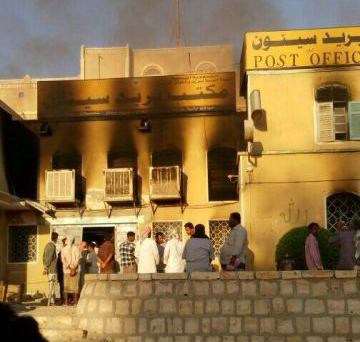
When I first arrived in Yemen, early in 1978, I found a virtual janna, a country building itself up by the sandalstraps, people who were welcoming, tribesmen who did more than wear their honor on their sleeves, a sense that the future would bring good things. It was not a land frozen in time, despite the lack of infrastructure and Western amenities, but a force for change as Yemenis took to entrepreneurship as second nature (which it, of course, always was). Development was in the air and on the ground, as bilateral and United Nations agencies poured money into Yemen, much of it ineffectual and wasted. In 1978 USAID was sponsoring a major sorghum improvement project in Yemen, a boondoggle that did little more than collect seeds for the University of Arizona’s seed bank. Given what I learned about Yemeni farmers’ knowledge, they should have been giving advice to the United States on how to grow sorghum. Much ado was made about building up the capacity of the central government, although the money flowing in through the various programs invited corruption rather than sustainable growth. Still, I have felt over the years that Yemenis, by and large, have the resolve and grit to persevere.
In the past three and a half decades Yemen has experienced ups and downs. A population estimated around 6 million or less back then has skyrocketed to some 24 million today. With the decline in subsistence agriculture, which at least filled stomachs, poverty and malnutrition are greater today than they were in 1978. The devastating loss of remittance wealth, which fueled Yemen’s grass-roots development in the 1980s, has led to chronic unemployment. The much touted unification in 1990, a kalashnikov wedding in hindsight, could not overcome the power politics and regional rivalry that have played out in the last two decades. The removal, or at least side-lining, of Ali Abdullah Salih has thus far not resulted in progress towards a peaceful solution to Yemen’s agonizing conflicts. The problem is not so much the inability of Yemen to renew itself, but the continual interference from outside forces. Continue reading Yemen from Janna to Jahannam